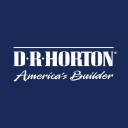Similar companies
| Company | Revenue | |
|---|---|---|
| No data for previous quarter available yet. | ||
Income Statement (NONE)
| Q1 '25 | QoQ | |
|---|---|---|
| Revenue | 7.73B | 1.6% |
| Gross Profit | 7.73B | 304.9% |
| Operating expense | 899M | 2.3% |
| Net Income | 810M | 4.1% |
Balance Sheet (NONE)
| Q1 '25 | QoQ | |
|---|---|---|
| Total Assets | 35.7B | 1.9% |
| Total Liabilities | 10.8B | 13.2% |
| Total Equity | 24.9B | 2.4% |
| Shares Outstanding | 314M | 2.9% |
Cash Flow (NONE)
| Q1 '25 | QoQ | |
|---|---|---|
| Cash from operations | -436M | 167.5% |
| Cash from financing | -77M | 96.3% |
EPS
Financial Highlights for D.R. Horton in Q1 '25
D.R. Horton reported a revenue of 7.73B, which is a 1.6% change from the previous quarter. An increase in revenue typically indicates growing demand for the company's products or services. This positive change in revenue is a good sign, suggesting that the company's sales are moving in the right direction.
Gross Profit stood at 7.73B, marking a 304.9% change since the last quarter. Gross profit showcases the efficiency in production and sales processes.
Operating Expenses for this period were 899M, showing a 2.3% change from the last quarter. Operating expenses cover the costs of running daily business operations. A significant increase might indicate inefficiencies or investments in growth, while a decrease could suggest cost-saving measures or potential underinvestment in key areas.
Net Income for the quarter was 810M, showing a -4.1% change from the prior quarter. Net income provides a clear picture of the company's profitability after all expenses. An increase suggests the company is becoming more profitable, while a decrease may raise concerns about the company's financial health, unless there are specific one-time costs or investments.
D.R. Horton faced some challenges this quarter with a decline in one or more of the key metrics: revenue, gross profit, or net income. Higher operating expenses might indicate increased investments or potential inefficiencies. A decline in EBITDA signals potential operational challenges or increased costs.

